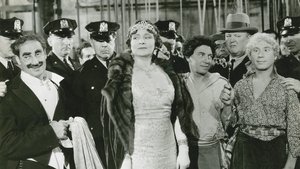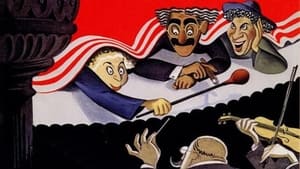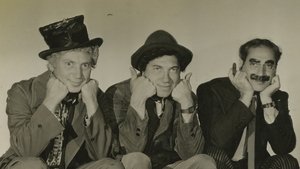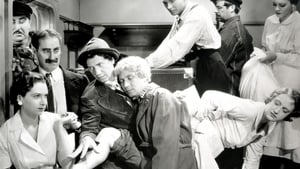Video Sources 0 Views
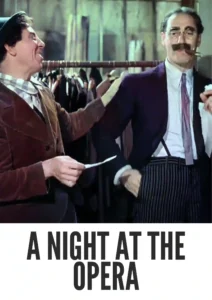
Synopsis
Hilarity in High Society: A Night at the Opera (1935) in Vibrant Color

Step into the madcap world of the Marx Brothers with A Night at the Opera, a timeless comedy musical from 1935, now beautifully colorized for a fresh viewing experience. Starring the iconic Groucho Marx, this film delivers a riotous blend of slapstick, witty banter, and musical numbers set against the backdrop of the opera world. If you enjoy classic comedies, then this HD download brings a beloved piece of cinematic history to your screen.
A Night at the Opera Storyline: Anarchy at the Opera
A Night at the Opera follows the escapades of Otis B. Driftwood (Groucho Marx), a shrewd businessman, and Fiorello (Chico Marx) and Tomasso (Harpo Marx), two mischievous associates, as they navigate the high society of the opera world. Their antics revolve around helping a young tenor, Ricardo Baroni, and soprano, Rosa Castaldi, achieve stardom while hilariously disrupting the pretentious world of opera.From chaotic stateroom scenes to uproarious backstage antics, the Marx Brothers unleash their signature brand of anarchy and satire. They challenge social norms, mock authority, and turn the opera house into their personal playground. The film culminates in a sidesplitting performance where the Marx Brothers create havoc and orchestrate a series of comedic mishaps. Ultimately, A Night at the Opera is a fast-paced and endlessly entertaining comedy that showcases the genius of the Marx Brothers. The movie is also known as “Marx Brothers at the Opera.”
Movie Cast
The film features a stellar cast of comedic talents:
- Groucho Marx as Otis B. Driftwood
- Chico Marx as Fiorello
- Harpo Marx as Tomasso
- Kitty Carlisle as Rosa Castaldi
- Allan Jones as Ricardo Baroni
Movie Genre
A Night at the Opera is a definitive comedy musical, blending slapstick, satire, and musical numbers. Its timeless humor and memorable scenes have solidified its place as a classic in the genre.
Historical Context: The Marx Brothers’ Golden Age
Released in 1935, A Night at the Opera represents a peak in the Marx Brothers’ career, showcasing their unique brand of comedy during the Golden Age of Hollywood. The film was produced during a time when movie musicals were gaining immense popularity. A Night at the Opera remains a significant cultural artifact and an enduring example of comedic brilliance.
Colorization Details
This colorized version of A Night at the Opera has been carefully restored using modern digital techniques, enhancing the visual appeal while preserving the film’s original comedic spirit. The colorization process involved analyzing the grayscale tones of the original black and white footage and assigning appropriate colors to each scene. This meticulous process brings new life to the characters and settings, making the story even more engaging for modern audiences. While debates may continue regarding colorizing classic films, it introduces these films to a wider audience, ensuring their legacy for future generations.
Technical Details
- Director: Sam Wood
- Screenplay: George S. Kaufman, Morrie Ryskind
- Story: James Kevin McGuinness
- Cinematography: Merritt B. Gerstad
- Edited by: William LeVanway
- Production Company: Metro-Goldwyn-Mayer
- Distributed by: Metro-Goldwyn-Mayer
- Runtime: 96 minutes
Technical Specifications
- Download Format: MP4
- Resolution: HD (1080p)
- Compatibility: Compatible with most devices, including smartphones, tablets, computers, and smart TVs.
Reviews and Critical Reception
A Night at the Opera (1935) is widely regarded as one of the Marx Brothers’ finest films, celebrated for its comedic brilliance, memorable scenes, and timeless appeal. Its influence can be seen in countless comedies that followed, cementing its legacy as a cornerstone of comedic cinema. As a beloved and enduring film, A Night at the Opera continues to delight audiences with its anarchic humor and unforgettable characters.
FAQs
- Q: What is A Night at the Opera about?
- A: A Night at the Opera is a comedy about the Marx Brothers causing chaos in the opera world.
- Q: Is A Night at the Opera (1935) a well-known Marx Brothers film?
- A: A Night at the Opera is one of the Marx Brothers’ most famous and beloved films, known for its iconic scenes and comedic brilliance.
- Q: Is this version of A Night at the Opera colorized?
- A: Yes, this version has been professionally colorized to enhance the viewing experience.
- Q: What makes A Night at the Opera so special?
- A: A Night at the Opera showcases the Marx Brothers’ unparalleled comedic talent, offering a perfect blend of slapstick, satire, and witty banter.
- Q: What is the download format?
- A: The download format is MP4, which is compatible with most devices.
- Q: What resolution is the download?
- A: The resolution is HD (1080p), providing a high-quality viewing experience.
Download Now in HD!
Watch A Night at the Opera Today!
